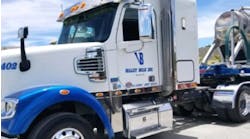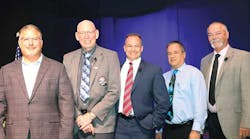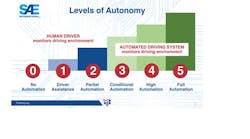Latest from Tank Fleets
KAG absorbs Evergreen Transport
BeyondTrucks expands integration hub
PSG acquires cryogenic pump manufacturer
NTTC driver experts discuss soft skills coaching and mentoring, open-door communication, and ways to avoid complacency and improve training
NATIONAL Tank Truck Carriers chairman John Wittington hosted a question-and-answer session with a panel of driver safety experts during the annual NTTC Safety & Security Council meeting in Reno, Nevada, including Foodliner driver Paul Emerson, the 2017-18 Professional Tank Truck Driver of the Year, Foodliner training director Jon Stenzel, Carbon Express safety director John Bowlby and Groendyke safety manager Mike Elmenhorst.
They touched on topics ranging from soft skills coaching and mentoring, to driver awareness, open-door communication and avoiding complacency during the session, called “How to achieve a safety focus in your team.”
Questions and answers are edited for length and clarity.
Whittington: How do you look at soft skill coaching and mentoring, and how does that work with Foodliner’s training?
Stenzel: “We found, at Foodliner, that’s an area of opportunity for us. We haven’t arrived, we have a way to go, because that’s an area we overlooked in the past, but we’ve really homed in on it recently.
“But you hire folks who can drive a truck, and they can sign the paperwork, they can unload the product, but how are they doing that? What kind of image are we portraying? Do we have a good attitude? Do we have a good work ethic, do we have integrity, do we have knowledge – some of those skills that we’ve overlooked.
“We’ve incorporated it into our orientation, part of our training, so every driver gets that when they come on board. We have driver training meetings once a year at the corporate office, we have follow up meetings with them, training as well, and we hold annual meetings for our regional managers and other staff, where we also bring in special expert guests who can continue our education process.”
Whittington: How does Groendyke’s safety as a value work into the goal of constantly improving on process?
Elmenhorst: “We all talk about value, and I looked it up – it’s a person’s principles or standards of behavior, or one’s judgement of what’s important in life – and we have a new vision, mission and value statement that came out this year, and at the top of the six values is safety. And it’s not that it just became a value this year. Safety has always been a value at Groendyke.
“That’s one thing, as I’ve moved up through the company, I’ve seen. If a driver gets nothing else, that’s the first thing he learns. We treat it as a value, and that has gotten us where we are today and will continue to take us where we want to be. Sometimes it takes some of them a little longer to understand that, because they’re used to hearing other companies – and not tank companies – espouse something different, about what they want drivers to understand, so sometimes we have to pound it into their head.”
Whittington: How does driver awareness tie into public awareness?
Emerson: “When we’re aware of what we’re doing, then we can project that awareness to the public. If we’re out there driving like gentlemen and following the rules of the road – we’re driving at a safe speed, we’re driving good, safe equipment – the public sees that. They also see the cowboys, but they see us, too, and when we’re aware of what we’re doing, they become aware of what we’re doing.”
Whittington: Drivers are responsible for everything they do on the road. How does Carbon Express create a culture where they have the autonomy to say “No, I’m not going to do anything unsafe,” but still stay successful?
Bowlby: “We basically make sure from the very beginning, when they come in for orientation, that they know they’re the captain of the ship. They can be told by dispatch or even the owner of the company, ‘I need you to do this, I need you to do that,’ but if they feel it’s unsafe, they have the ability to call me and I will have their back, regardless of who’s telling them what to do.
“They need to understand they are the ones on the road. They can see the weather conditions, they can see the traffic conditions that we can’t see sitting in the office, so they’ve got to be the eyes and ears for us.”
Whittington: How does Foodliner use its open-door communication policy and risk assessment scorecard to improve safety?
Stenzel: “The open-door policy’s pretty easy, from the owner on down. We request that they follow the chain of command, and talk to their immediate supervisor, but if they don’t get what they need, they can go to the next level, all the way up to Greg (McCoy), the owner of the company. Now, does that happen at times? Yea. And does that stir the feathers a little bit at times? Yea. But again, the ultimate goal is to fix problems, so if we get our feathers ruffled a little bit in the process … it’s really worthwhile.
“Regarding the scorecards, obviously we talk a lot about safety and service and so on, and I’m sure everyone has some sort of metrics or measurement system. We have many, but we have two that are like the bible – risk assessment and CSA. So, if a driver has a disconnect or an exception, the first thing we do is look at the risk assessment and the CSA scorecard, because they tell us everything about that driver – if they’ve had problems in the past, their remedial training and so on.
“A little bit deeper than that, every Tuesday we get together at the corporate office, with regional managers, directors and VPs, and talk about every preventable accident, service failure, cargo claim and injury from the previous week, and you talk about getting emotions up. Sometimes the paperwork that comes in from the manager looks like they’re trying to side with the other driver, or maybe it has the other driver’s perspective, so we get some heated battles through that, but again, the ultimate goal is to make us better, and make improvements through that process.”
Whittington: What are Groendyke’s driver guidelines/training program, and how does that fit into the driver review process?
Elmenhorst: “Every driver, preferably within the first 90 days, comes into Enid (Oklahoma) and goes through Mr. Poppy’s orientation class down there, where one of the main focuses is to get them acclimated with who Groendyke is, as well as getting cards and some of the other training that needs to be done. They learn safety is No. 1, they learn what they’re supposed to do in an emergency response, so we track everything. We want them to call us. Also, we use an internal scorecard called RALPH that looks at different behaviors, and then we use that in our annual reviews, not to beat them up, but to change behaviors.
“With our speed gauge, we have a goal that they’re supposed to be under 1 percent, and it’s used in our annual review, and sometimes 30- and 60-day reviews, and we use that to plant in their minds we really mean what we’re saying. They’re not just words.”
Whittington: The age-old saying that things that get measured get improved goes along with that, and then also just giving folks feedback. I know I’ve struggled in the past with giving reviews to employees, but each time I do it we seem to see some measurable improvement. People want feedback. They want to know where they stand, even if it’s not good. At least it gives a baseline to go from there.
Elmenhorst: “We were used to every year doing the MBR – here, sign this. But that’s part of the process. As humans, we all want to know how we’re doing, and we all have behaviors both good and bad, so if I want you to change your behavior, I have to identify what is your behavior, explain to you what I want you to do, and then how it’s going to make your life better. If it doesn’t make your life better, it’s not going to happen.”
Whittington: What can you tell us about the dangers of this epidemic of distracted driving, and how can your companies help our drivers stay focused?
Emerson: “The system is in the training. We need to train our people what these distractions are. Many people don’t stop to think about things like lighting a cigarette, taking a bite of food or a drink of coffee, even an allergy. You sneeze, you close your eyes for 3 seconds. And a lot of people aren’t aware of that because they’re just normal habits. They’re going to smoke, they’re going to drink, they’re going to eat going down the road.
“So, we need to teach them how to deal with distracted driving. We need to drive in that circle of safety, where we’re not only watching what’s in front of us, but out 300 feet, 600 feet, what’s besides us, what’s behind us, and watch for distractions.
“Highway patrol are trained in this. You ask a highway patrolman, ‘What’s that driver doing?’ Well, he’s a drug dealer, I can tell. He’s a drunk, I can tell. That guy’s been driving too long, he’s sleepy, I can tell. So, you can train people to look for these things.”
Whittington: What do you do when you see another driver who appears distracted?
Emerson: “I adjust my speed, I might change lanes, I’m not going to get near him, because when you look out there and you see somebody doing something that’s a little on the silly side, think to yourself, ‘What’s the stupidest thing that person can do?’ and 65 percent of the time that’s exactly what they’ll do.”
Whittington: How does Carbon Express guard against driver complacency?
Bowlby: “We’ve done a couple of things. In the past year, we’ve added cameras in trucks. Every time there’s a stability report or hard-braking report, it generates a video, which I review. Recently I had a driver who’s been with us for 25 years have a hard-braking report, and looking at it, because the video will go back in time, I saw three serious violations, including coasting through a stop sign. Here’s a guy with 25 years’ worth of experience, so I not only talked to him, I also shared that video with the rest of the fleet, letting them know, even though you’ve got 25 years of experience, you still can let your guard down.
“Another thing we do are newsletters. Sometimes it might be considered morbid but I will find news stories about a truck driver maybe going to jail for 15 to 20 years because he ran into the back of six cars and killed some people, or it might be a tanker that rolled over and the driver was killed in the fire, or a picture of a minivan that’s been compacted down to a couple square yards and there’s a family of four inside. I’ll send that out to all the drivers to make them aware that you can’t let your guard down, even for a couple seconds. You can’t be distracted. You’ve got to leave the cell phone, and the food, alone, and you’ve got to pay attention all the time.”
Whittington: What is Foodliner’s take on complacency?
Stenzel: “We are testing cameras. We’ve got a couple different camera systems that we’re testing. Obviously, that can give you some good insight on things we don’t know about, because even experienced drivers do get complacent. I don’t know that anybody has a silver bullet, but it’s every second of every day, and we try to use every tool we can from our mobile app to online internet training to one-on-one safety meetings. We bring folks in annually, a couple times a year. Any time we have an opportunity, we try to talk it, and obviously we have to make sure we’re walking the walk as well. So that’s a tough one, and it’s ongoing every second of every day.”
Whittington: Foodliner also has a full retention program in place. Can you tell us a little bit about that?
Stenzel: “Two years ago, we hired a retention specialist … (and) started that process. She makes calls, with a welcome call after the first seven days a driver is with us, and then 30, 60 and 90 days. If somebody leaves, for whatever reason, we want to find out the details on that. We also do anniversary and birthday calls, so sometimes we’re catching the husband or wife at home, and that has a pretty good impact as well. So we’re just trying to do everything we can within that program to retain drivers. We all know the driver market is crazy, and if we get family involved, that has another whole effect on that person coming on and staying with us.”
Whittington: What is Groendyke’s certified driver instructor training process? By teaching those good habits, are you finding that new driver safety scores are improving?
Elmenhorst: “We have a driver instructor process. It’s called a SEAL DI, which is a Safety Education Awareness Lever. They all come in to Enid, they go through three days, with half the time spent in class and half the time spent on the road with one of my field safety coordinators, and then Chris has Rosie (Wildo Rosario), who is professor of Groendyke U, and he’s system certified, so they learn the Smith (defensive driving) system.
“We’re now looking at our process, and considering maybe changing and condensing it, because when we have a 130-140 SEAL DIs, we have realized … we aren’t getting evenness across the system. One guy’s focused on this, one guy focuses on that. So we are now looking at it, we are interviewing the guys who are in training, or just came out of training – all the SEAL DIs – and looking at maybe going to a regional type. We have driver instructors who are year-round, that’s all they do, and we’ll take them out of the operations side, because I’ve been in operations, so I know how that is, and if you’ve got a driver over there you don’t want him to cut back on his productivity. That’s why we’re constantly looking at all our processes and seeing how we can improve things.
“As we move forward, and get closer to the end, we feel like we’re going to get stronger training, because one guy’s focused on this, and we want them to be focused on everything. I know that when we come to the end of this we will have strengthened our SEAL DI program and have better training coming out. Because if we don’t sufficiently train them – all of us – and he comes out of training and does something wrong, his confidence level goes way down, and it’s sometimes real difficult to save them. So, at the end of this, we want consistency on what the trainee knows when he comes out of the system.”
Whittington: What’s the feedback from the drivers on that?
Elmenhorst: “In doing the interviews, we have discovered that we have a lot of wasted time in our training program, because … depending on what they are, they can be anywhere from a five-day, which is a rehire, to a 28-day (trainee), and that doesn’t mean that at the end of five days or 28 days they go out. The SEAL DI makes that decision, when they’re ready to go. But we’ve discovered there’s a lot of sitting, because they’re hauling loads and stuff like that, and we feel we can bring some of that into the classroom and then get them through the actual training process of delivering loads faster, and have a better product when it does come out.”
Whittington: We’ve talked a lot about behavioral training and teaching folks how to do what’s right. From another angle, how does maintenance tie into the job of being safe?
Emerson: “Our behavior is rated by our stress. There is a lot of stress in this job, and having ill-maintained equipment adds to that stress. So, if you’re going down the road knowing you’ve got good tires, good brakes and your engine is going to keep running, it takes a lot of that stress away. We’ve seen road rage. The more stress you put on people, the worse it gets, so anything we can do to alleviate that stress level helps our drivers.”













